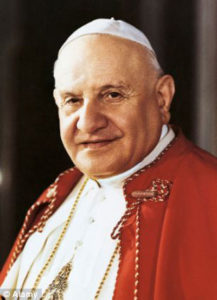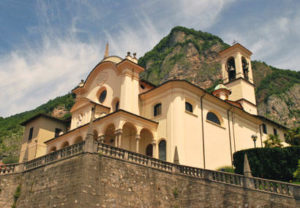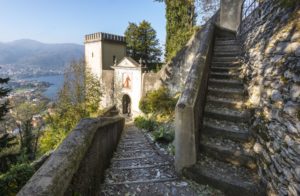In childhood there is often a unique and unrepeatable event, a mythical event that solidifies in the depths of the heart in a clot of reality that affects all life: it can be positive or negative, it can dramatically fix the past or give unity to the person and joyfully open to the future. When it has a positive charge it creates affective warmth and intense joy, it enlightens and helps to interpret one’s own existence, it orients and determines personal choices at decisive moments.
A similar, very beautiful experience happened to little Angelo Roncalli, the future Pope Saint John XXIII, when he came as a pilgrim to the sanctuary of Saint Jerome with his good mother. From then on, Somasca is indelibly accompanied for him by the memory of his childhood, by an intense experience of the sacred, by the social and religious value of the pilgrimage, by the affectionate memory of the mother who gave him life, who raised him and educated him and everything is colored by an intense, joyful family tenderness.
“The first and only time I went up there (to Somasca) was with my good mother when I was a little boy of six or seven years old; and I still remember my childhood impressions” (Diary 7 September 1919).
“The memories of their holy founder, Saint Jerome Miani, were the joy of my childhood, since my good mother accompanied me to contemplate them in Somasca, so close to my native village” (Libro Atti comunità di Mestre, 18 September 1955).
“Dear Somasca’s faithful, I always come back willingly to these places, because Somasca has something different from other countries: I was born in your mountains, so dear to my heart and that I remembered with emotion even when I was away from Italy. In Somasca I had been there as a boy and passing in front of the house, transformed into a chapel that was not rich, who then accompanied me said to me: Saint Jerome died here!” (Homily to the faithful of Somasca, 26 September 1953)
Somasca, so close to his village, is part of the landscape of his soul, of his familiar places where he perceived the beauty of nature, the enchantment of life, and becomes the backdrop of a sacred land where you feel the presence of Mary, God’s masterpiece. This is a memory that also accompanies him as Pope, when on 26 August 1960 he wrote to Card. Montini, recalling how he crowned the Virgin Mary on 29 August 1954 in the sanctuary of the Madonna del Bosco, near Sotto il Monte and Somasca: a memory that preserves “the sweetness of an unforgettable enchantment”.
“Oh what a spectacle, more heavenly than earthly: the figure of our serene and majestic Mother, overlooking the summit of the Scala Santa, from the background of the river bubbling between the two shores of Brianza and Bergamo, in the face of the delightful panorama which adorn the open and tranquil slopes of Villa d’Adda, and, towards evening, the last offshoots of Val San Martino, from Caprino to Celana, beyond Calolzio, beyond Somasca, ergentisi on the buttresses of the Resegone magnificent and dominant.” (Letter from Pope John to Cardinal Montini, 28 August 1960)
As a Renaissance painter, Pope John represents and relives in his memory the coronation of Our Lady of the Woods. The Madonna is there at the center and above with the arm of the Child Jesus and around her a magnificent landscape on which the sacredness and mystery spread: there is the river Adda that flows down, with the hilly scenery of Brianza and Bergamo; the bottom of the San Martino Valley appears, with its villages named one after the other, Caprino, Celana, Calolzio, Somasca, that rise on the buttresses of the dominant Resegone. It is undoubtedly a step of high and sublime eloquence, that the recipient of the letter, the then Card. Montini, a man of extraordinary culture and a very fine scholar, could not help but appreciate.
Somasca, the land of San Girolamo, father of the orphans for the liberation of Mary, is a point of reference for the spirituality of St. John XIII and also a kind of locus amenus, a small place dear to you, where you return with your thoughts to rest and distract yourself from pastoral care. “Elected Cardinal and Patriarch of Venice, I have become, in a certain sense, a relative of Saint Jerome. And Saint Jerome, you see, is one of the greatest saints in Venice. In the Patriarch’s chapel there is a large painting, where many saints are depicted. Of these, some have a miter, some have a crown, some the crosier; Saint Jerome instead is there’ who clings to the orphan’s side pointing to the sky. How beautiful, you know our Saint Jerome. Converted to Quero by Mary, Mother of Orphans, he illuminated the world with the light of his charity… I will have in my heart a small, very dear place for Somasca, which will be a reason for sweet distraction in my care as Patriarch”. (Homily to the faithful of Somasca, September 26, 1953)
Somasca, sanctified by the charity of Saint Jerome, cradle of the Congregation of the Somascans Fathers, also guided some of Roncalli’s pastoral choices. He established an immediate bond, strong bonds between Bergamo and Venice, between the land of San Marco and Somasca, the special relationship of San Girolamo: “Strong bonds bind me to Venice. I come from Bergamo, the land of San Marco; behind my hill is Somasca, the speco of San Girolamo”. (Speech during the rite of entry into Venice as Patriarch, 15 March 1953)
There is a Manzonian quotation in the text. Card. Roncalli likes to compare himself both to the Lombard and Manzonian Renzo, who crosses the Adda to reach the land of San Marco, and to the Venetian San Girolamo, who leaves Venice and comes to Lombardy: “Remember the good Renzo, who crossed the Adda said: safe land, land of St. Mark”; but when the Patriarch from Venice comes to Como he confronts St. Jerome, “who, too, from the shores of the Adriatic was taken westwards to Somasca, just to the left of the Adda, where it ceases to be lake and takes its name of river”. (Homily for the 3rd centenary of the parish of the Crucifix of Como, 27 June 1954)
An important pastoral decision was to bring the Somascans back to the diocese of Venice, an objective achieved with the assignment to the Somascans of the Parish of the Pilgrim Mother of Mestre, Altobello, an area then poor and peripheral: “I mark this day among the most joyful of my pastoral life in Venice … for the return to their homeland of origin of the Somascans Fathers after a century and a half of desolate absence …. As soon as I arrived in Venice as Patriarch, I immediately felt the desire and the intention to bring this beloved and holy religious family back to its starting point. Today everything is done! (Libro Atti comunità di Mestre, 18 September 1955) This was an intent already expressed both in Somasca in the homily of 26 September 1953: “I have a vow in my heart: and it is that in Venice the sons of St. Jerome return to revive the spirit of charity of their founder … I wish it to become a reality soon” and in Como on 27 June 1954 on the occasion of the 3rd centenary of the Parish of SS. Crucified: “I wish to have them back in Venice … I would like to mature more and more the plan that they return to Venice, where their founder has left.”
A further pastoral intervention by Pope Roncalli in favor of Somasca was the concession of the title of Minor Basilica to the Sanctuary of San Girolamo shortly after his election as Roman Pontiff. The rather arid legal text is animated at the beginning and at the end by personal memories: “Between the region of Bergamo, which is so dear to us, because it is our homeland, and the territory of Venice there were many civil and ecclesiastical relations. The example of Saint Girolamo Emiliani is worth remembering: born into a Venetian family, when in the 16th century he moved to the territory of Bergamo he lived for a long time in Somasca, he did admirable things… We then, who since our youth have in our hearts that glorious land, ennobled by the holiness of Saint Girolamo Emiliani, very willingly decided to welcome such priests…”. Some of his collaborators actually claimed that the church of Somasca was too small and that it didn’t deserve such a title. But Pope John who knew the sanctuary, the little valley, the holy staircase well, the hermitage cut short: “Somasca is all a basilica”, taking up in some way what he had already said in his inaugural speech in Venice: “Somasca is the specus of Saint Jerome”, that is a sacred place – and not only a church – saturated with prayer, contemplation and penance.
A final observation: in the imagination of Pope Roncalli Somasca is connected to childhood, to the mother figure, to the cradle. On his agenda, on September 28, 1947, he had fixed the points of his homily for the celebration in a “feast full of fervor, of poetry in the memories of the great Saint: 1st the memories of my first visit to Somasca; 2nd the exercise of charity; 3rd above all charity towards the little ones, hope for the future, towards the humble, towards the workers of the fields”.
A thought that will return again in his simple, brief but beautiful homily of September 26, 1953: “And now, dear children, I give you a blessing, a great blessing indeed that goes where there is a cradle, where there is one who cries, where there is suffering that you want to hide, so that the blessing could comfort and help all. And God’s blessing may come upon you and always remain there.” The concept was taken up in similar words in St. Peter’s Square on the evening of October 11, 1962, the day the Council began during the famous “speech to the moon”: “Returning home you will find your children. Give them a caress and say: this is the caress of the Pope”.
Seven pilgrimages of Saint John XXIII to Somasca are documented: one visit in his childhood (perhaps in July 1887 or 1888), a second visit on September 7, 1919, again in 1921 with Card. Laurenti, on 28 September 1947 on the second centenary of the beatification of Saint Jerome; on 26-27 September 1953 for the consecration of the altar of the Church of the Mater Orphanorum; on 3 August 1955 in private form; on 26 August 1956 together with his Venetian seminarians.
We hope that imitating Saint John XXIII many faithful today will continue to choose his places of pilgrimage in the territory of Bergamo: Sotto il Monte, his native town, where he was baptized and often returned to rest during his holidays, the sanctuary of Our Lady of the Woods, the smile of his childhood and guardian of his priestly vocation, and Somasca, “a whole basilica, the specus of Saint Jerome”, where the Father of orphans exercised his charity and immersed himself in contemplation, penance and prayer.
Fr. Giuseppe Oddone, CRS





Cardinal Roncalli (future St. John XXIII, Pope) addresses to the faithful gathered in Somasca
26th September, 1953Cardinal Roncalli speaks to the faithful of Somasca
Dear brothers and sisters of Somasca, I always come back gladly to these places, because Somasca has something different from other places. You can see around the altar a new flourishing of children of St. Jerome, who with such precision and precision perform the liturgical song of the Church and the sacred ceremonies.
There are two reasons why I have come here with you, O faithful of Somasca. The first is that I was born in your mountains, so dear to my heart and that I remembered with emotion even when I was far from Italy. In Somasca I had been there as a boy and, passing in front of the house, now transformed into a chapel that was not rich, but pretty and cozy, who accompanied me said to me: “St. Jerome died here!” The second reason is that having the Holy Father, for his great goodness, elected Cardinal and Patriarch of Venice, I became in a certain sense a relative of St. Jerome.
In the private chapel of the Patriarch of Venice, where for ten years I was preceded by a blessed Patriarch, a saint, there are large paintings, where many saints are depicted. One of these, some have a mitre, some a crown, some a crosier; S. Girolamo, on the other hand, is there holding the orphans beside him, pointing to the sky. How beautiful, you know, our St. Jerome! So think of my great sorrow for not being able to participate in the most solemn day of the feast that you do to Our Lady, Mother and Queen of orphans …
You see, dear faithful of Somasca, we have so much to learn from St. Jerome. At first I had believed that St. Jerome was a priest, but reading his life I saw that he was a layman and that as a young man, until his mother lived, he remained faithful to God’s law, but then became a bit runaway. These failures teach us two things: it is astonishing that a layman has been able to do so many beautiful and great things, but this tells us that holiness consists above all in great common sense; moreover, it is precisely the family education, the training given by the mother that leaves its mark throughout his life.
St. Jerome was a young man from a noble family, and he was also a soldier and let himself be taken a little by pleasure, by the desire for glory, by all that is called worldly spirit. He was a brave soldier and was put in charge of a fortress. He fought like a hero, but the Germans, who were Germans even then, joined Maximilian and occupied the castle, but it was in the prison that he played the hour of the Lord and did not wait for a single moment, and became a saint, the saint of charity.
St. Jerome, you see, is a bit like St. Augustine. I was in Africa and visited the country where he was born. St. Augustine, you know, converted to Milan through the work of St. Ambrose. He converted and became a saint and enlightened the world with the light of his science, while Jerome converted in Quero through the work of Mary, Mother of orphans, and enlightened the world with the light of his charity; and this light spread in an extraordinary way, carrying the name of Somasca throughout the world.
…And I, dear faithful, have a vow in my heart: and it is that in Venice the children of St. Jerome return to revive with all kinds of activities, even with the press, since in Venice there is still a printing house that was once of the Somaschi Fathers, the spirit of charity of their Holy Father Founder, St. Jerome. And I, who have seen with immense pleasure the flourishing of this beloved Congregation, wish that this vow that I keep in my heart, will soon become reality, and for this reason pray, pray a lot also to you.
I have finished, my dear ones, but I tell you that I will always keep a grateful memory of these days spent with you for the feast of Our Lady of the Orphans, and I will have in my heart a small very dear place for Somasca, which will be a reason for sweet distraction in my care as Patriarch.
And you too, dear faithful, if you can, come and visit me in Venice, which is also a beautiful city and I will not be able to welcome you as the worldly people usually do, but I will have the same many things to tell you and to show you.
And now, dear children, I give you a blessing, a great blessing that goes from where there is a cradle, where there is a weeping child, where there is a pain that you want to hide, so that all might receive comfort and help, and the blessing of God almighty descend on you and always remain with you.
His Eminence Cardinal Roncalli, Patriarch of Venezia
Somasca, September 26, 1953
